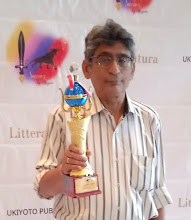Once upon a time there were two brothers in a village. The elder brother was of the gentle and peaceful type while the younger one was openly villainous, foul and quarrelsome. After their respective marriages, the petty quarrels became serious, and so they decided to separate—building their own houses dividing the same plot of land. On the border between them was a longish pond and the elder brother’s household did not even catch a fish coming out of that pond to their area on a rainy day as it was not their property. Occasionally on some issues the younger brother used to storm into the elder’s house—threatening him with a dagger at times. Although the boycott was total for decades the new generations of both households used to meet often defying the ban; some of them were close friends; a few of them went to different cities on jobs and there, members of both families used to enjoy togetherness freely. The point being made here is that a boycott plan does not even work at the microscopic level. Therefore, at the macro level where it involves two large countries who are neighbors too a boycott plan is totally unrealistic, harmful for both and unworkable. India and China should get this message straight and sweet.
Why exactly the rather primitive skirmishes between the Indian army and China’s Peoples Liberation Army happened at the Line of Actual Control (LAC) in Ladakh in the night of 15th June 2020 happened is not known and is not revealed by either side. Both countries charged each other of violating rules and being aggressive first. The soldiers reportedly used rods, clubs and stones and fought within the Indian side of the LAC. A Colonel of the Indian army along with 19 soldiers were martyred while the Chinese never revealed the casualties on their side even as news agencies put the figure of their casualties at 43. Deaths of 20 brave-hearts created waves of shock, disbelief and anger across India—many questioning the government why the Indian army did use arms even after an officer of the rank of a Colonel got killed. Knowledgeable sources refer to a bilateral agreement signed between the two countries in 1996 which prohibited use of firearms within two kilometers of either side of the LAC. The uproar against the Chinese aggression which, in fact, started about three months back when US President Trump charged China with mishandling and spreading the new Coronavirus led naturally to waves of patriotism and jingoism and a total boycott plan of Chinese goods and products. While at the official levels some contracts with China were terminated several people’s organizations took up the movement against Chinese goods.
China has been India’s biggest trade partner after the US, and it accounts for nearly 12% of India’s total imports. China accounts for more than 70% of India’s cell phone market, and supplies various other products like toys, firecrackers, garments etc. at the cheapest possible prices which allow thousands of vendors do business with profit margins. Various multi-national corporations are working with huge Chinese investments. Some corporates point out the there is nothing wrong with Chinese investments because it helps creating employment and allowing huge benefits for consumers. Self-reliance goals for India cannot be achieved overnight, it has to be a long-term strategy. From China’s point of view too it cannot ignore a huge and growing market like India and so cannot risk antagonizing India to a more serious extent. There are reasons why both countries dislike each other: India doesn’t like China’s growing closeness with Pakistan in the last one year while China doesn’t at all approve of India’s proximity with the US; there is also the general opinion about China’s ambition of emerging as a global superpower which is in sharper focus now due to USA’s apparent disastrous handling of the COVID-19 pandemic and the equally disastrous fallout.
Both countries are suffering from extensive economic downswing because of the COVID spread; China managed to effectively control the pandemic with a total lock-down but is now fearing a second wave while India now is in the thick of the virus and in the throes of the unlocking process. Both countries desperately need to recover economically; China is much ahead of India in terms of economic growth for over a decade but cannot afford to suffer further losses; with probable negative growth rate threatening India for the next fiscal it cannot at all risk another disaster.
Therefore, a boycott plan would prove disastrous for both the countries and would heighten the tension not subsiding as yet. Prospect of a war should be the last thought on their minds. Continuous dialogue and negotiations are the natural course to take for both countries. Patriotism is good and righteous, but it should never be at the expense of the country. People of India should realize this, and the government should educate the citizens on this rather than trying to capitalize on passions of patriotism and jingoism.


Comments
Post a Comment
Hi! Welcome! Please comment what you feel! 😊